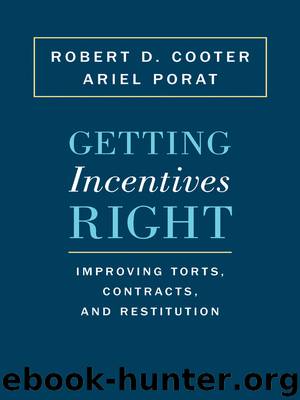Getting Incentives Right: Improving Torts, Contracts, and Restitution by Robert D. Cooter & Ariel Porat

Author:Robert D. Cooter & Ariel Porat [Cooter, Robert D.]
Language: eng
Format: epub
Publisher: Princeton University Press
Published: 2014-02-23T03:00:00+00:00
E. Anti-Insurance for Gains
When several actors affect a risk, efficient incentives require each of them to bear the full risk. So far we have applied this proposition to the risk of losses, and now we apply it to the risk of gains.
Example 6: Agency Contract. Principal and Agent need each other’s cooperation and effort to sell business computers. Agent must locate interested buyers, and Principal must negotiate and tailor the contract to the buyers’ needs. Total sales depend upon effort and luck. The current contract requires Principal to give 50 percent of profits from sales to Agent.12 To incentivize both parties fully, Agent must receive 100 percent of value created by a sale and Principal must also receive 100 percent. To achieve this goal, the parties buy anti-insurance. Principal and Agent pay Anti-Insurer a fixed sum in advance of sales, and the Anti-Insurer matches dollar for dollar the revenue from sales. By matching all profits with anti-insurance, the Principal and Agent each receive 100 percent of the value created by their joint efforts.
In this example, anti-insurance causes the Principal and Agent to internalize the entire profits from sales, so they work harder. Because expected profits increase, they can pay the anti-insurer enough in advance for everyone to benefit.
Now we state the precise difference between anti-insurance for gains and anti-insurance for losses. Anti-insurance for gains means that promisor and promisee pay the anti-insurer a flat fee in advance for his promise to pay them an amount equal to any gain that they subsequently realize. Anti-insurance for losses means that the anti-insurer pays a flat fee in advance for the promise of the promisor and promisee to pay him an amount equal to any loss that they subsequently realize. Mixed cases also arise when realizations can be positive or negative.
Here is an example from legal practice.
Example 7: The Law Firms. Two law firms work together for the plaintiff on a bodily injury case for a contingent fee. Firm A is responsible for proving liability, Firm B is responsible for establishing damages. Their effort is unobservable and unverifiable. With optimal effort by each of them, the probability is .30 that they will win the case and receive a fee of 200. Initially they agree to split their winnings equally, but then they realize that they have suboptimal incentives. Each firm will externalize half of the benefit associated with its effort, so self-interest compels each firm to exert effort until its marginal cost equals half of the resulting marginal gain to both of them. The probability will be .15 that they will win the case and receive a fee of 100. To improve incentives, they buy anti-insurance for gains. If they win the case, the anti-insurer pays them an amount equal to the fee. Now both parties have optimal incentives, so the probability is .30 that the anti-insurer will pay them 200. In exchange for anti-insurance, the two firms pay the anti-insurer 60 in advance, which is the anti-insurer’s expected cost. The anti-insurer expects to break even (his expected costs are .
Download
This site does not store any files on its server. We only index and link to content provided by other sites. Please contact the content providers to delete copyright contents if any and email us, we'll remove relevant links or contents immediately.
Objection! by Nancy Grace(1762)
Apeirogon by Colum McCann(1675)
Anatomy of Injustice by Raymond Bonner(1641)
That Every Man Be Armed by Stephen P. Halbrook(1560)
Civil Procedure (Aspen Casebooks) by Stephen C. Yeazell(1532)
The Vaccine Court by Rohde Wayne(1488)
Injustices by Ian Millhiser(1479)
Storytelling for Lawyers by Meyer Philip(1442)
A Practical Guide to International Arbitration in London by Hilary Heilbron(1413)
Restitution by Restitution(1408)
Coercing Virtue by Robert H. Bork(1340)
Broken Scales by Joel Cohen(1334)
Tangled Webs: How False Statements Are Undermining America: From Martha Stewart to Bernie Madoff by James B. Stewart(1320)
The Tools of Argument: How the Best Lawyers Think, Argue, and Win by Joel Trachtman(1295)
A Matter of Interpretation by Antonin Scalia(1290)
INDEFENSIBLE: One Lawyer's Journey Into the Inferno of American Justice by Feige David(1268)
American Tragedy by Lawrence Schiller & James Willwerth(1260)
A Religious Orgy in Tennessee by H.L. Mencken(1235)
Tangled Webs by James B. Stewart(1232)
